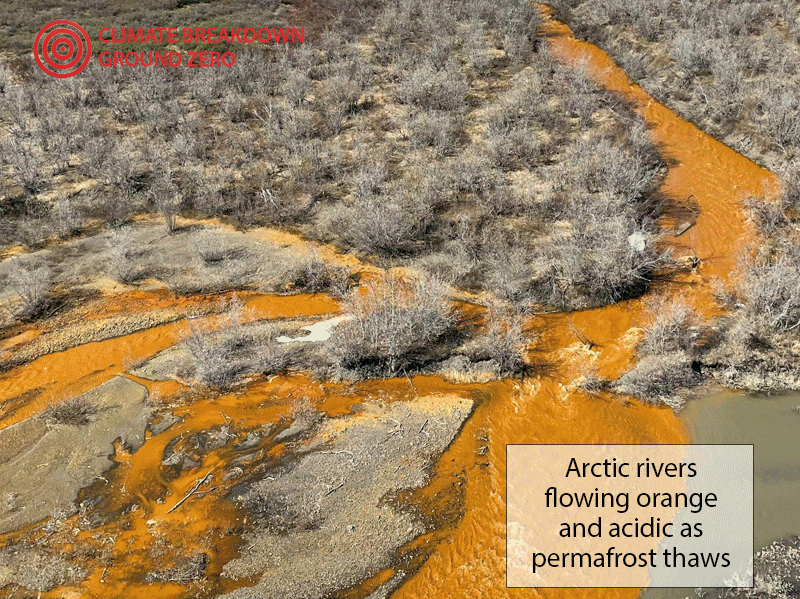“The alarming thing is how far our human reach is, in a big way.”
– Roman Dial, Prof. Biology, Alaska Pacific University.
Unless one follows the breakdown of the planetary climate system, most people aren’t aware that many of Alaska’s rivers are now flowing a rusty orange and turning seriously acidic, as chemicals once locked by the frozen permafrost begin to leach out into surrounding waterways.
This recent Arctic development is directly related to an earlier post that reported several other consequences of rapid permafrost thaw. In that post I summarized several climate phenomena triggered by the thawing of permafrost and the resulting release of methane gas from various places it has been stored for a long time. The developments include exploding methane craters, flammable bubbling lakes, marine seafloor frozen CH4 clathrates and creeping megaslumps.
(I did NOT cover the collapse of the Arctic human infrastructure or the very possible emergence of viruses and bacteria also trapped by frozen ground – two more separate topics.)
Now we see another alarming scenario brewing, as the iconic Salmon River, the Agashashok River and number of other Alaskan waterways – about 75 at this point – are flowing hazy orange, with acidity levels running 100 times higher than expected and low dissolved oxygen measurements. According Scientific American’s January 1 article, analysis of the waterway shows it contains high levels of manganese and iron that are similar industrial wastewater. And yet this river was once described as having “water of exceptional clarity.”
This is not the usual mining wastewater scenario, which is caused directly by human dumping of poison from extraction sites. Rather it is one step removed: as anthropomorphic global warming raises temperatures, it melts the tundra faster, releasing microbes that free yet more trapped greenhouse gases and so on…we’ve covered this particular feedback before.
There are other reports – not verified at this point – that the same thing is happening in northern Canada and Siberia. Given the cause and effect trail, it would be surprising if it were not. And the emerging situation may be worse than what can been seen: the ominous discoloration is determined by the chemical makeup of a specific watershed’s sediments, so not all contaminated rivers will look rusty. Sadly, the acidic pH levels (6.4) are far more dangerous to river life and surrounding ecosystems, and that data is not visible.

Scientists at this point are indicating that the minerals are leaching out of rock that has been newly exposed to water and suddenly active bacteria in defrosting wetlands are also releasing iron, manganese and other elements.
Although we expect this phenomenon to worsen rapidly, it has already negatively affected the indigenous way of life. The increased quantities of dissolved minerals and salts in the waters of the Wulik and Kobuk rivers to increase, threatening the drinking water supply for native communities. The affects are seen in fish and wildlife, with key staple fish species are reported deformed in increasing numbers.
There is a certain amount of low grade irony in the fact that many the most powerful effects of global heating are taking place in the relative cold of the Arctic. Not only is this region warming three time faster than the rest of the planet, but visual evidence of ecosphere collapse in the far North tends to takes more exotic and dramatic form than in the lower latitudes: Exploding craters, flammable lakes, crashing glaciers. But comparatively few humans live in the Arctic and therefore miss all the powerful evidence of the broken climate on display.
It will only be when extreme weather events and the serious disruptions to the food supply affect their own lives that people will truly understand.